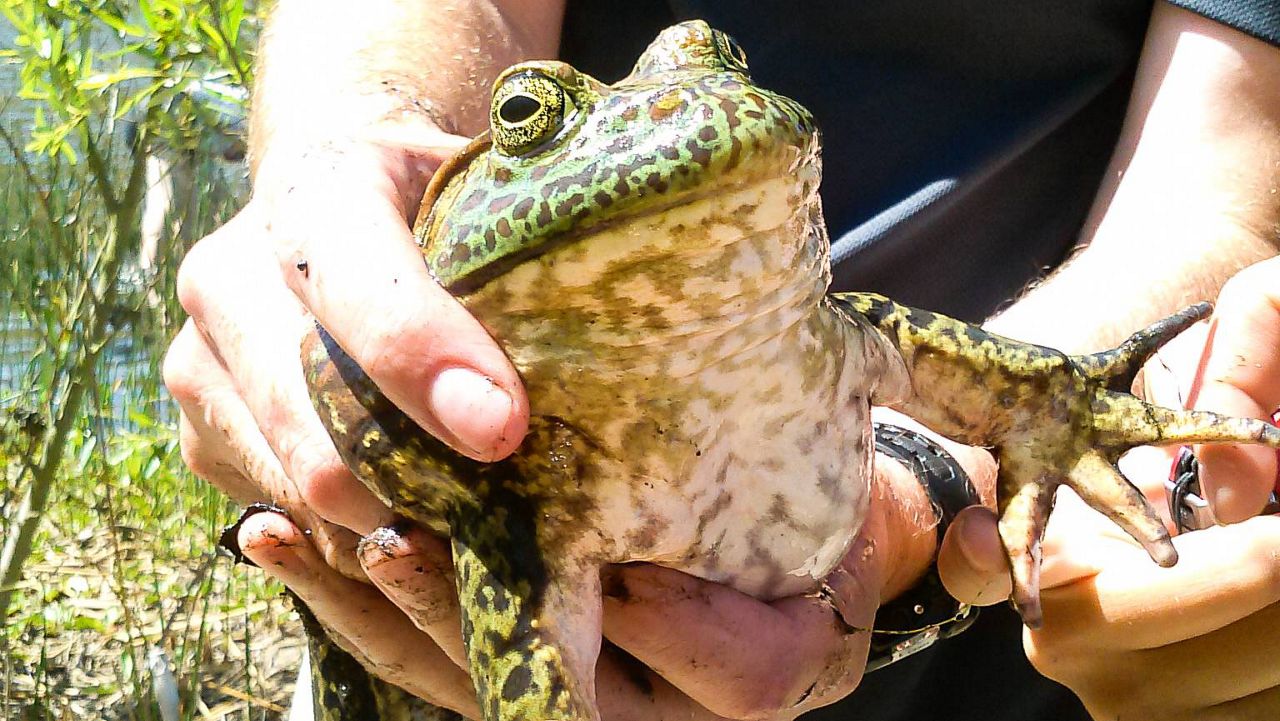HONOLULU — Hawaii Pacific University Master of Marine Science student Heidi Beswick Cutia is on a mission to learn more about invasive bullfrogs in Hawaii hoping to protect native and endemic animals.
Bullfrogs (Rana catesbeiana) were brought from their home in eastern North America to Hawaii around 120 years ago, so that people could eat their long legs. The bullfrogs now live on all the main Hawaiian Islands. However, they should not be confused with the more commonly spotted bufo toads that are brown and bumpy, and might be found hopping around in your backyard. Instead, bullfrogs are smooth and bright green, and always in or near water.
While there have been some previous studies about the amphibians, little is known about them. Cutia is currently building a genetic tree of the bullfrog and researching what they eat in Hawaii.
“We should be caring about that, because bullfrogs are inhabiting these wetland ecosystems, where a lot of our endangered birds are also located,” said Cutia.
Bullfrogs are hypothesized to eat other animals that live in wetlands, including endangered Hawaiian stilt chicks, endemic snails and endemic insects.
Cutia described the bullfrogs as greedy, as they often eat too much and will choke on their food, and as wayfarers, traveling up to a mile during wet seasons and spreading easily.
A U.S. Fish and Wildlife Service study from 2004 put radio collars on endangered stilt chicks at the James Campbell Wildlife Refuge and found that when they could determine the cause of death for the stilts that 77% of them were being eaten by bullfrogs.
Along with the harm bullfrogs cause in low-elevation wetlands, they’re also able to scale steep waterfalls, traveling into high-elevation streams and wetlands, such as those atop the Koʻolau Range.
“That's where we have a lot of our native species, because habitat up in the high elevations tends to be a little more pristine; it doesn't have a lot of human influence up there,” said Cutia.
Building a genetic tree will illustrate how many times the bullfrogs were introduced in Hawaii, which Cutia said might give land managers a better sense of how to prevent more invasions from happening. It will also provide clues to the genetic diversity of bullfrogs in Hawaii, which is important to understand because species with less genetic diversity will have less success surviving. She is also looking to see if the bullfrogs in Hawaii have any morphological differences, such as having a greater head width, which would allow them to eat larger creatures.
Hawaii is often called the “extinction capital of the world” with 71 of at least 113 endemic bird species already having been lost since the arrival of humans; Cutia says this is “a big reason” she is researching the bullfrogs, as a way to investigate every possible threat to Hawaii’s native and endemic plants and animals.
Cutia is dissecting the bullfrogs in order to see what they eat, besides the stilt chicks. She hypothesizes that they could be eating endemic moorhen chicks as well as invasive creatures like snails, centipedes and cane spiders.
Cutia hopes her research, which is expected to be completed in May 2022, will be useful to land managers, allowing them to decide how to prioritize management of bullfrogs. At the James Campbell National Wildlife Refuge, land managers are already working to control bullfrog populations.
“I think there are probably other locations here in Hawaii, where bullfrogs aren't quite as managed, and maybe it's because people don't know what kind of impacts they could be having,” said Cutia.
CORRECTION: A previous version of this story incorrectly stated the bullfrogs are known to eat endemic snails and insects. The error has been corrected. (Feb. 22, 2022)








